|

by Jeff Rense
from
Rense Website
On
Wednesday, February 25, 1942, five years before
Roswell, five years
before pilot Kenneth Arnold's landmark sightings of "flying saucers"
in the Pacific Northwest, 3 years before the Battle of the Bulge,
two years before D-Day, and years before the so-called "modern UFO
era" had officially begun, there was the Battle of Los Angeles,
arguably the most sensational, dramatic UFO mass encounter on
record.
Have you ever heard of the Battle of Los Angeles? Few have.
Imagine
a visiting spacecraft from another world, or dimension, hovering
over a panicked and blacked-out LA in the middle of the night just
weeks after Pearl Harbor at the height of WWII fear and paranoia.
Imagine how this huge ship, assumed to be some unknown Japanese
aircraft, was then attacked as it hung, nearly stationary, over
Culver City and Santa Monica by dozens of Army anti-aircraft
batteries firing nearly 2,000 rounds of 12 pound, high explosive
shells in full view of hundreds of thousands of residents. Imagine
all of that and you have an idea of what was the Battle of Los
Angeles.
The sudden appearance of the enormous round object triggered all of
LA and most of Southern California into an immediate wartime
blackout with thousands of Air Raid Wardens scurrying all over the
darkened city while the drama unfolded in the skies above... a drama
which would result in the deaths of six people and the raining of
shell fragments on homes, streets, and buildings for miles around.
Dozens of gun crews and searchlights of the Army's 37th Coast
Artillery Brigade easily targeted the huge ship which hung like a
surreal magic lantern in the clear, dark winter sky over the City of
the Angels.
Few in the city were left asleep after the Coastal
Defense gunners commenced firing hundreds and hundreds of rounds up
toward the glowing ship which was apparently first sighted as it
hovered above such west side landmarks as the MGM studios in Culver
City.
The thump of the batteries and the ignition of the aerial
shells reverberated from one end of LA to the other as the gun crews
easily landed scores of what many termed "direct hits".... all to no
avail.
Here now, is what the night skies of LA looked like at the
height of the firing....
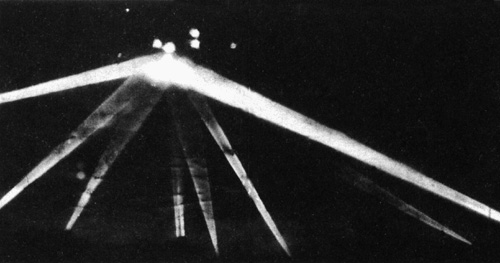
New 7-24-00 photo enhancements and anaylsis
shows the huge craft caught in the converging spotlights!
Wednesday, February 25, 1942
Pay close attention to the convergence of the searchlights and you
will clearly see the shape of the visitor within the illuminated
target area. It's a BIG item and seemed completely oblivious to the
hundreds of AA shells bursting on and adjacent to it which caused it
no evident dismay.
There were casualties, however... on the ground.
At least 6 people died as a direct result of the Army's attack on
the UFO which slowly and leisurely made its way down to and then
over Long Beach before finally moving off and disappearing.
In February, 1942, Katie was a young, beautiful, and
highly-successful interior decorator and artist who worked with many
of Hollywood's most glamorous celebrities and film industry
luminaries.
She lived on the west side of Los Angeles, not far from
Santa Monica. With the outbreak of the war with Japan and the rising
fear of a Japanese air attack, or even invasion of the West Coast,
thousands of residents volunteered for wartime duties on the home
front. Katie volunteered to become an Air Raid Warden as did 12,000
other residents in the sprawling city of Los Angeles and surrounding
communities.
In the early morning hours of February 25th, Katie's phone rang. It
was the Air Raid supervisor in her district notifying her of an
alert and asking if she had seen the object in the sky very close to
her home.
She immediately walked to a window and looked up.
"It was
huge! It was just enormous! And it was practically right over my
house. I had never seen anything like it in my life!" she said. "It
was just hovering there in the sky and hardly moving at all."
With
the city blacked out, Katie, and hundreds of thousands of others,
were able to see the eerie visitor with spectacular clarity.
"It was
a lovely pale orange and about the most beautiful thing you've ever
seen. I could see it perfectly because it was very close. It was
big!"
The U.S. Army anti-aircraft searchlights by this time had the object
completely covered.
"They sent fighter planes up (the Army denied
any of its fighters were in action) and I watched them in groups
approach it and then turn away. There were shooting at it but it
didn't seem to matter."
Katie is insistent about the use of planes
in the attack on the object. The planes were apparently called off
after several minutes and then the ground cannon opened up.
"It was
like the Fourth of July but much louder. They were firing like crazy
but they couldn't touch it."
The attack on the object lasted over
half an hour before the visitor eventually disappeared from sight.
Many eyewitnesses talked of numerous "direct hits" on the big craft
but no damage was seen done to it.
"I'll never forget what a
magnificent sight it was. Just marvelous. And what a gorgeous
color!", said Katie.
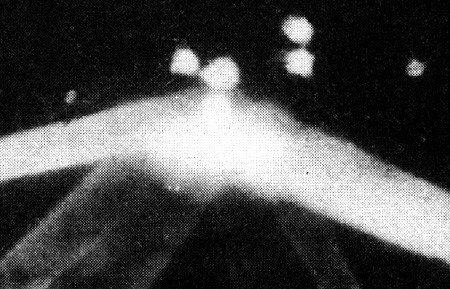
"The object...caught in the center of the lights like the hub of a
bicycle wheel surrounded by gleaming spokes. The fire seemed to
burst in rings all around the object."
The ONLY description in the LA Times of the UFO, and a sense of the
energy and emotion of that night, was found in this small sidebar
article written by Times staff writer the day after the event:
Chilly Throng Watches
Shells Bursting In Sky
by Marvin Miles
Explosions stabbing the darkness like tiny bursting stars...
Searchlight beams poking long crisscross fingers across the night
sky... Yells of wardens and the whistles of police and deputy
sheriffs...
The brief on-and-off flick of lights, telephone calls,
snatches of conversation:
'Get the dirty...'
That was Los Angeles
under the rumble of gunfire yesterday.
RESIDENTS AWAKENED
Sleepy householders awoke to the dull thud of explosions...
"Thunder? Can't be!"
Then:
"Air Raid! Come here quick! Look over
there... those searchlights. They've got something... they are
blasting in with anti-aircraft!"
Father, mother, children all
gathered on the front porch, congregated in small clusters in the
blacked out streets - against orders. Babies cried, dogs barked,
doors slammed.
But the object in the sky slowly moved on, caught in
the center of the lights like the hub of a bicycle wheel surrounded
by gleaming spokes.
SPECULATION RIFE
Speculation fell like rain.
"It's a whole squadron."
"No, it's a
blimp. It must be because it's moving so slowly."
"I hear planes."
"No you don't. That's a truck up the street."
"Where are the planes
then?"
"Don't know. They must be up there though."
"Wonder why they
picked such a clear night for a raid?"
"They're probably from a
carrier."
"No, I'll bet they are from a secret air base down south
somewhere."
Still the firing continued. Like lethal firecrackers,
the anti-aircraft rounds blasted above, below, seemingly right on
the target fixed in the tenacious beams.
Other shots fell short,
exploding halfway up the long climb. Tracers sparked upward like
roman candles. Metal fell. It fell in chunks, large and small; not
enemy metal, but the whistling fragments of bursting ack-ack shells.
The menacing thud and clank on streets and roof tops drove many
spectators to shelter.
WARDENS DO GOOD JOB
Wardens were on the job, doing a good job of it.
"Turn off your
lights, please. Pull over to the curb and stop. Don't use your
telephone. Take shelter. Take shelter."
On every street brief glares
of hooded flashlights cut the darkness, warning creeping drivers to
stop. Police watched at main intersections. Sirens wailed enroute to
and from blackout accidents. There came lulls in the firing. The
search lights went out. (To allow the fighter planes to attack?).
Angelinos breathed deeply and said,
"I guess it's all over."
But
before they could tell their neighbors good night, the guns were
blasting again, sighting up the long blue beams of the lights.
WATCHERS SHIVER
The fire seemed to burst in rings all around the target. But the
eager watchers, shivering in the early morning cold, weren't
rewarded by the sight of a falling plane.
Nor were there any bombs
dropped.
"Maybe it's just a test," someone remarked. "Test, hell!"
was the answer. "You don't throw that much metal in the air unless
you're fixing on knocking something down."
Still the firing
continued, muttering angrily off toward the west like a distant
thunderstorm. The targeted object inched along high, flanked by the
cherry red explosions.
And the householders shivered in their robes,
their faces set, watching the awesome scene.
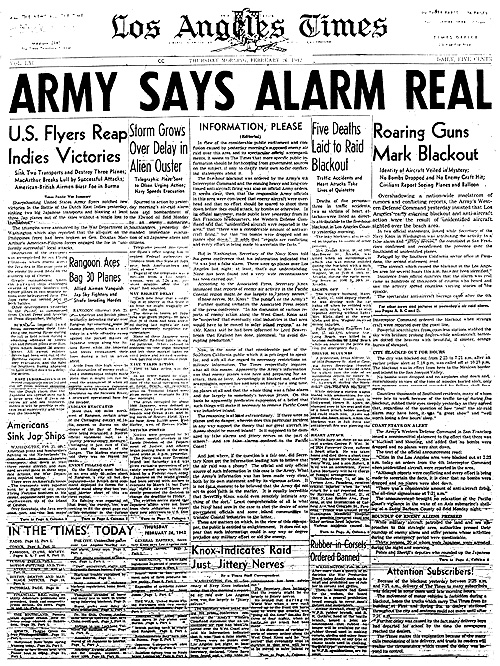
The following are excerpts from the primary front page story of the
LA Times on February 26th.
Note that there is not a SINGLE
description of the object even though is was clearly locked in the
focus of dozens of searchlights for well over half an hour and seen
by hundreds of thousands of people:
Army Says Alarm Real
Roaring Guns Mark Blackout
Identity of Aircraft Veiled in Mystery; No Bombs Dropped and
No Enemy Craft Hit; Civilians Reports Seeing Planes and Balloon
Overshadowing a nation-wide maelstrom of rumors and conflicting
reports, the Army's Western Defense Command insisted that Los
Angeles' early morning blackout and anti-aircraft action were the
result of unidentified aircraft sighted over the beach area.
In two
official statements, issued while Secretary of the Navy Knox in
Washington was attributing the activity to a false alarm and
"jittery nerves," the command in San Francisco confirmed and
reconfirmed the presence over the Southland of unidentified planes.
Relayed by the Southern California sector office in Pasadena, the
second statement read:
"The aircraft which caused the blackout in
the Los Angeles area for several hours this a.m. have not been
identified."
Insistence from official quarters that the alarm was
real came as hundreds of thousands of citizens who heard and saw the
activity spread countless varying stories of the episode. The
spectacular anti-aircraft barrage came after the 14th Interceptor
Command ordered the blackout when strange craft were reported over
the coastline.
Powerful searchlights from countless stations stabbed
the sky with brilliant probing fingers while anti-aircraft batteries
dotted the heavens with beautiful, if sinister, orange bursts of
shrapnel.
City Blacked Out For Hours
The city was blacked out from 2:25 to 7:21 am after an earlier
yellow alert at 7:18 pm was called off at 10:23 pm. The blackout was
in effect from here to the Mexican border and inland to the San
Joaquin Valley.
No bombs were dropped and no airplanes shot down
and, miraculously in terms of the tons of missiles hurled aloft,
only two persons were reported wounded by falling shell fragments.
Countless thousands of Southland residents, many of whom were late
to work because of the traffic tie-up during the blackout, rubbed
their eyes sleepily yesterday and agreed that regardless of the
question of how "real" the air raid alarm may have been, it was "a
great show" and "well worth losing a few hours' sleep."
The blackout
was not without its casualties, however. A State Guardsman died of a
heart attack while driving an ammunition truck, heart failure also
accounted for the death of an air raid warden on duty, a woman was
killed in a car-truck collision in Arcadia, and a Long Beach
policeman was killed in a traffic crash enroute to duty.
Much of the
firing appeared to come from the vicinity of aircraft plants along
the coastal area of Santa Monica, Inglewood, Southwest Los Angeles,
and Long Beach.
In its front page editorial, the Times said:
"In view of the
considerable public excitement and confusion caused by yesterday
morning's supposed enemy air raid over this area and its spectacular
official accompaniments, it seems to The Times that more specific
public information should be forthcoming from government sources on
the subject, if only to clarify their own conflicting statements
about it."
"According to the Associated Press, Secretary Knox intimated that
reports of enemy air activity in the Pacific Coastal Region might be
due largely to 'jittery nerves.' Whose nerves, Mr. Knox? The
public's or the Army's?"
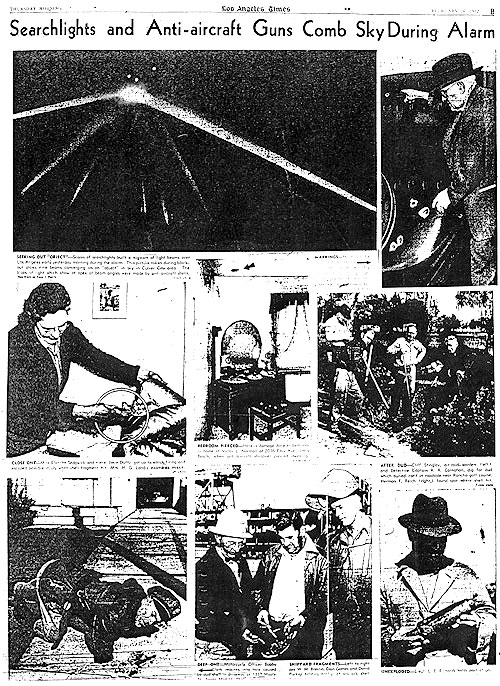
The following is an excerpt of an article appearing in Fate
Magazine.
Our special thanks to Bill Oliver of UFO*BC for
transcribing and bringing it to our attention.
WORLD WAR II UFO SCARE
by Paul T. Collins
Fate Magazine July, 1987
On Wednesday, February 25, 1942, as war raged in Europe and
Asia, at least a million Southern Californians awoke to the
scream of air-raid sirens as Los Angeles County cities blacked
out at 2:25 AM.
Many dozed off again while 12,000 air raid
wardens reported faithfully to their posts, most of them
expecting nothing more than a dress rehearsal for a possible
future event - an invasion of the United States by Japan. At
3:36, however, they were shocked and their slumbering families
rudely roused again, this time by sounds unfamiliar to most
Americans outside the military services.
The roar of the 37th Coast Artillery Brigade's antiaircraft
batteries jolted them out of bed and before they could get to
the windows the flashing 12.8 pound shells were detonating with
a heavy, ominous boomp - boomp - boomp and the steel was already
raining down. All radio stations had been ordered off the air at
3:08. But the news was being written with fingers of light three
miles high on a clear star-studded blackboard 30 miles long.
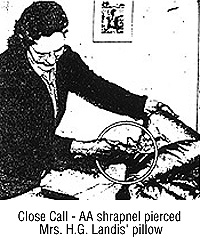 The firing continued intermittently until 4:14. Unexploded
shells destroyed pavement, homes and public buildings, three
persons were killed and three died of heart attacks directly
attributable to the one hour barrage. Several persons were
injured by shrapnel. A dairy herd was hit but only a few cows
were casualties. The firing continued intermittently until 4:14. Unexploded
shells destroyed pavement, homes and public buildings, three
persons were killed and three died of heart attacks directly
attributable to the one hour barrage. Several persons were
injured by shrapnel. A dairy herd was hit but only a few cows
were casualties.
The blackout was lifted and sirens screamed all clear at 7:21.
The shooting stopped but the shouting had hardly begun. Military
men who never flinched at the roar of rifles now shook at the
prospect of facing the press. While they probably could not be
blamed for what had happened, they did have some reason for
distress.
The thing they had been shooting at could not be
identified.
Caught by the searchlights and captured in photographs, was an
object big enough to dwarf an apartment house. Experienced
lighter-than-air (dirigible) specialists doubted it could be a
Japanese blimp because the Japanese had no known source of
helium, and hydrogen was much too dangerous to use under combat
conditions.
Whatever it was, it was a sitting duck for the guns of the 37th.
Photographs showed shells bursting all around it. A Los Angeles
Herald Express staffer said he was sure many shells hit it
directly. He was amazed it had not been shot down.
The object that triggered the air raid alarm had drawn 1430
rounds of ammunition from the coast artillery, to no effect.
When it moved at all, the object had proceeded at a leisurely
pace over the coastal cities between Santa Monica and Long
Beach, taking about 30 minutes of actual flight time to move 20
miles; then it disappeared from view.
You can well imagine with what chagrin public information
officers answered press queries. The Pasadena Office of the
Southern California Sector of the Army Western Defense Command
simply announced that no enemy aircraft had been identified; no
craft was shot down; no bombs were dropped; none of our
interceptors left the ground to pursue the intruder.
Soon thereafter US Navy Secretary
Frank Knox announced that no
planes had been sighted. The coastal firing had been triggered,
he said, by a false alarm and jittery nerves. He also suggested
that some war industries along the coast might have to be moved
inland to points invulnerable to attacks from enemy submarines
and carrier-based planes.
The press responded with scathing editorials, many on page one,
calling attention to the loss of life and denouncing the use of
the coast artillery to fire at phantoms. The Los Angeles Times
demanded a full explanation from Washington. The Long Beach
Telegram complained that government officials who all along had
wanted to move the industries were manipulating the affair for
propaganda purposes.
And the Long Beach Independent
charged:
"There is a mysterious reticence
about the whole affair and it appears some form of
censorship is trying to halt discussion of the matter.
Although it was red-hot news not one national radio
commentator gave it more than passing mention. This is the
kind of reticence that is making the American people gravely
suspect the motives and the competence of those whom they
have charged with the conduct of the war."
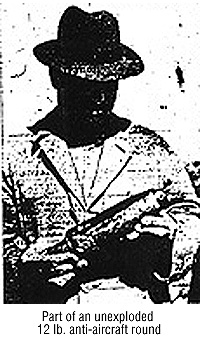 The Independent had good reason to
question the competence of some of the personnel responsible for
our coastal defense operations as well as the integrity and
motives of our highest government officials. The Independent had good reason to
question the competence of some of the personnel responsible for
our coastal defense operations as well as the integrity and
motives of our highest government officials.
Only 36 hours
before the Long Beach air raid, a gigantic Japanese submarine
had surfaced close to shore 12 miles north of Santa Barbara and
in 25 minutes of unchallenged firing lobbed 25 five-inch shells
at the petroleum refinery in the Ellwood oil field. The Fourth
Interceptor Command, although aware of the sub's attack, ordered
a blackout from Ventura to Goleta but sent no planes out to sink
it.
Not one shot was fired at the sub.
After the Ellwood incident had alerted all the West Coast
defense posts to possible repeat attacks, these units were
sensitive to anticipated invasion attempts. By Wednesday morning
in the Los Angeles area they were ready to open fire on a boy's
kite if it in any way resembled a plane or a balloon. Secretary
of War Henry Stimson praised the 37th Cost Artillery for this
attitude.
It is better to be a little too alert than not alert
enough, he said. At the same time he delicately suggested that
it might have been a good idea to send some of our planes up to
identify the invading aircraft before shooting at them.
Planes of the Fourth Interceptor Command were, in fact, warming
up on the runways waiting for orders to go up and interview the
unknown intruders.
Why, everybody was asking, were they not
ordered to go into action during the 51-minute period between
the first air-raid alert at 2:25 AM and the first artillery
firing at 3:16?
Against this background of embarrassing indecision and
confusion, Army Western Defense Command obviously had to say
something fast. Spokesmen told reporters that from one to 50
planes had been sighted, thus giving themselves ample latitude
in which to adjust future stories to fit whatever propaganda
requirements might arise in the next few days.
When eyewitness reports from thousands searching the skies with
binoculars under the bright lights of the coast artillery
verified the presence of one enormous, unidentifiable,
indestructible object - but not the presence of large numbers of
planes - the press releases were gradually scaled downward. A
week later Gen. Mark Clark acknowledged that army listening
posts had detected what they thought were five light planes
approaching the coast on the night of the air raid.
No
interceptors, he said, had been sent out to engage them because
there had been no mass attack.
Believing an aerial bombardment was in progress, some people
thought they saw formations of warplanes, dogfights between
enemy craft and our fighter planes and other things that they
assumed were evidence of such an attack. Obviously there were no
dogfights because none of our interceptors were in the air.
Tracer bullets were fired from military ground stations and some
people mistook the fire pattern made by these projectiles for
aerial combat.
Other observers reported lighted objects which
were variously described as red-and-white flares in groups of
three red and three white, fired alternately, or chainlike
strings of red lights looking something like an illuminated
kite.
People suggested that some of these lights were caused by
Japanese-Americans signaling approaching Japanese aircraft with
flares to guide them to selected targets, but because no bombs
were dropped, the theory was quickly abandoned. In any case,
such charges fitted in perfectly with a hysterical press
campaign to round up all citizens of Japanese descent and put
them in concentration camps.
During the week of the Japanese submarine attack on the Ellwood
oil field and the air raid on Los Angeles County, the press took
full advantage of the made-to-order situation.
Arrests of
suspects were quickly made and the FBI was called in, but the
Long Beach Press Telegram stated all investigations indicated
nobody was signaling the enemy from the ground.
Santa Barbara's Ellwood
Oil Field Submarine Attack
Just a few days before the "Battle of LA" a Japanese submarine had
surfaced at night and fired its deck gun into the Ellwood oil field
located 12 miles northwest of Santa Barbara.
The LA Times:
"From Santa Barbara, area of the submarine attack Monday night,
District Attorney Percy Heckendorf said he would appeal to Lt. Gen.
John L. DeWitt, commanding officer of the Western Defense Command,
to make Santa Barbara County a restricted area for enemy nationals
and American-born Japanese as well.
"There is convincing proof," Heckendorf asserted, "that there were shore signals flashed to the
enemy."
Heckendorf said the people will hold Gen. DeWitt responsible
if he failed to act. Army ordinance officers, meanwhile, were
studying more than 200 pounds of shell fragments from missiles fired
by the submarine, which caused only $500 damage in the Ellwood oil
field near Santa Barbara."
It is said by some locals that the skipper or one of the officers on
the Japanese sub had worked in the Ellwood oil field some years
prior to the outbreak of the war.
The story claims that the man had
been mistreated by some of his co-workers during that time, had
returned to Japan before the war began, and had then subsequently
helped lead the submarine back to the area to make it's attack.
Army Gunners Fire
At UFOs Over Los Angeles
Courtesy UFO ROUNDUP
Volume 3, Number 8
February 22, 1998
Editor Joseph Trainor
On Wednesday, February 25, 1942, at precisely 2 a.m., diners at the
trendy Trocadero club in Hollywood were startled when the lights
winked out and air raid sirens began to sound throughout greater Los
Angeles.
"Searchlights scanned the skies and anti-aircraft guns protecting
the vital aircraft and ship-building factories went into action. In
the next few hours they would fire over 1,400 shells at an
unidentified, slow- moving object in the sky over Los Angeles that
looked like a blimp, or a balloon."
Author Ralph Blum, who was a nine-year-old boy at the time, wrote
that he thought "the Japanese were bombing Beverly Hills."
"There were sirens, searchlights, even antiaircraft guns
blaming
away into the skies over Los Angeles. My father had been a balloon
observation man (in the AEF) in World War One, and he knew big guns
when he heard them. He ordered my mother to take my baby sisters to
the underground projection room--our house was heavily supplied with
Hollywood paraphernalia--while he and I went out onto the upstairs
balcony."
"What a scene! It was after three in the morning. Searchlights
probed the western sky. Tracers streamed upward. The racket was
terrific."
Shooting at the aerial intruders were gunners of the 65th
Coast Artillery (Anti-Aircraft) Regiment in Inglewood and the 205th
Anti-Aircraft Regiment based in Santa Monica. The "white
cigar-shaped object" took several direct hits but continued on its
eastward flight.
Up to 25 silvery UFOs were also seen by observers on the ground.
Editor Peter Jenkins of the Los Angeles Herald Examiner reported,
"I
could clearly see the V formation of about 25 silvery planes
overhead moving slowly across the sky toward Long Beach."
Long Beach
Police Chief J.H. McClelland said,
"I watched what was described as
the second wave of planes from atop the seven-story Long Beach City
Hall. I did not see any planes but the younger men with me said they
could. An experienced Navy observer with powerful Carl Zeiss
binoculars said he counted nine planes in the cone of the
searchlight. He said they were silver in color.
The (UFO) group
passed along from one battery of searchlights to another, and under
fire from the anti-aircraft guns, flew from the direction of Redondo
Beach and Inglewood on the land side of Fort MacArthur, and
continued toward Santa Ana and Huntington Beach. Anti-aircraft fire
was so heavy we could not hear the motors of the planes."
Reporter Bill Henry of the Los Angeles Times wrote,
"I was far
enough away to see an object without being able to identify it...I
would be willing to bet what shekels I have that there were a number
of direct hits scored on the object."
At 2:21 a.m., Lt. Gen. John L. DeWitt issued the cease-fire order,
and the twenty-minute "battle of Los Angeles" was over.
(See
BEYOND
EARTH: MAN'S CONTACT WITH UFOs by Ralph Blum, April 1974, page 68. See also the Los Angeles Times, the Los
Angeles Herald-Examiner and the Long Beach Press-Telegram for
February 25, 1942. All newspaper quotes taken from "The Battle of
Los Angeles, 1942" by Terrenz Sword, which appeared in Unsolved UFO
Sightings, Spring 1996 issue, pages 57 through 62.)
60th Anniversary Of The Battle Of Los Angeles
from Frank Altomonte
alto@earthlink.net
February-18-2002
Excerpt from 'UFOs and the National Security State'
by Richard M. Dolan Keyhole
Publishing, 2000
"At least a million residents awoke to air raid sirens at 2:25am.,
and U.S. Army personnel fired 1,430 rounds of antiaircraft shells to
bring down what they assumed were Japanese planes. But these were
not Japanese planes. George Marshall wrote a memorandum to President
Roosevelt about the incident, which remained classified until 1974.
Marshall concluded that conventional aircraft were involved,
probably "commercial sources, operated by enemy agents for purposes
of spreading alarm, disclosing location of antiaircraft positions,
and slowing production through blackout."
Despite the barrage of American antiaircraft fire, none of these
"commercial" planes were brought down, although several homes and
buildings were destroyed, and six civilian deaths were attributed to
the barrage. Considering the carnage, the military's explanation was
meager. U.S. Navy Secretary Knox even denied that any aircraft had
been over the city; he called the incident a false alarm due to war
nerves.
The local press, needless to say, did not take this very well. The
Long Beach Independent noted that:
"There is a mysterious reticence
about the whole affair and it appears some form of censorship is
trying to halt discussion of the matter."
It is noteworthy that for
thirty years until the release of the Marshall memorandum, the
Department of Defense claimed to have no record of the event.
Five
years before
Roswell, them military was already learning to clamp
down on UFOs."
|





 The firing continued intermittently until 4:14. Unexploded
shells destroyed pavement, homes and public buildings, three
persons were killed and three died of heart attacks directly
attributable to the one hour barrage. Several persons were
injured by shrapnel. A dairy herd was hit but only a few cows
were casualties.
The firing continued intermittently until 4:14. Unexploded
shells destroyed pavement, homes and public buildings, three
persons were killed and three died of heart attacks directly
attributable to the one hour barrage. Several persons were
injured by shrapnel. A dairy herd was hit but only a few cows
were casualties. The Independent had good reason to
question the competence of some of the personnel responsible for
our coastal defense operations as well as the integrity and
motives of our highest government officials.
The Independent had good reason to
question the competence of some of the personnel responsible for
our coastal defense operations as well as the integrity and
motives of our highest government officials.